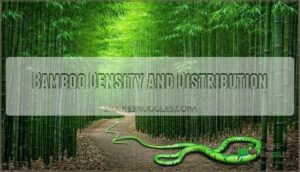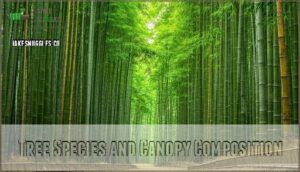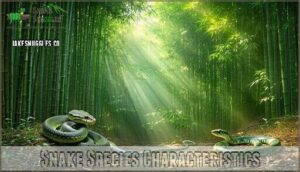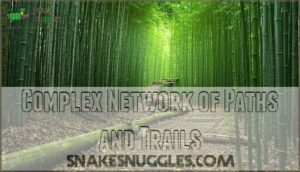This site is supported by our readers. We may earn a commission, at no cost to you, if you purchase through links.
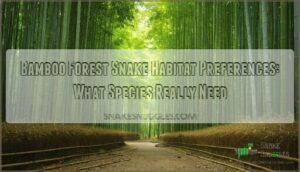
These serpents crave consistent moisture levels around 70-85% humidity, temperatures between 75-85°F, and thick canopy cover that filters harsh sunlight.
They’re drawn to areas where bamboo density provides excellent camouflage and abundant prey like birds, frogs, and small mammals, utilizing the vertical structure of bamboo forests.
The vertical structure of bamboo forests acts like nature’s apartment complex – offering multiple levels for hunting and shelter.
Understanding these specific needs reveals why certain bamboo regions become snake hotspots while others remain mysteriously empty.
Table Of Contents
- Key Takeaways
- Snake Habitat Preferences
- Bamboo Forest Structure
- Snake Species Characteristics
- Habitat Requirements
- Human Impact Factors
- Frequently Asked Questions (FAQs)
- Do snakes live in bamboo forests?
- What temperature do bamboo rat snakes like?
- Is bamboo forest a habitat?
- What size tank does a bamboo rat snake need?
- Where do bamboo snakes live?
- What type of habitat would have bamboo?
- What lives in the bamboo forest?
- How does climate change affect bamboo snake habitats?
- What adaptations help snakes thrive in bamboo forests?
- How do bamboo snakes contribute to forest ecosystems?
- Conclusion
Key Takeaways
- You’ll need to provide dense, humid environments with 70-85% humidity and temperatures between 75-85°F, as these conditions support snake thermoregulation and proper shedding cycles.
- You’ll find snakes prefer bamboo forests with thick canopy cover that creates vertical climbing highways and abundant prey like birds, frogs, and small mammals hiding in the multilayered structure.
- You’ll discover that consistent moisture levels and water sources within 50 meters double snake density compared to drier areas, making wetland corridors essential for population success.
- You’ll notice human activities like deforestation and climate change fragment habitats by 65% and push species beyond thermal tolerance limits, requiring immediate conservation action to prevent local extinctions.
Snake Habitat Preferences
You’ll find snakes in bamboo forests have specific needs that determine where they live and how they behave.
Understanding whether they prefer trees or ground level, plus their temperature and light requirements, helps you predict where you’ll spot different species.
Arboreal Vs. Terrestrial Habits
When you’re exploring bamboo forest habitat, you’ll notice snakes split into two distinct camps: the tree climbing specialists and forest floor dwellers.
Arboreal life demands different skills than terrestrial behavior – about 60% of bamboo-dwelling species choose snake trees for hunting and shelter.
These climbers show remarkable habitat selection, using bamboo’s vertical structure like nature’s jungle gym.
Meanwhile, ground-huggers prefer the rich leaf litter below, showcasing how snake ecology adapts to available niches in bamboo forest habitat.
Temperature and Humidity Requirements
Beyond vertical preferences, you’ll find that thermal regulation drives snake behavior in bamboo forests.
These reptiles can’t produce their own body heat, so they depend on microclimate conditions for survival.
Like tiny solar panels, snakes chase warmth patches throughout their bamboo world to stay alive.
Here’s what matters most for temperature and humidity:
- Thermal gradients – Snakes need temperature ranges from 70-85°F for ideal metabolism
- Humidity levels – Most species require 60-80% relative humidity for proper shedding
- Heat tolerance – Different species handle temperature fluctuations differently based on origin
- Microclimate pockets – Bamboo creates diverse temperature zones within small areas
Snake preferences vary substantially between species.
Some tolerate wider temperature fluctuations while others need stable conditions.
Bamboo forest habitat naturally provides these varied microclimates through dense canopy coverage and moisture retention.
Understanding these habitat ecology patterns helps predict where you’ll encounter different species.
Light Intensity and Basking Behavior
You’ll find that light filters through bamboo forests create perfect basking sites for thermoregulating snakes.
These reptiles carefully balance sun exposure with shade preference, moving between dappled light patches as temperatures shift.
The forest ecosystem’s filtered sunlight supports ideal reptile behavior, allowing snakes to regulate body temperature without overheating.
Understanding these snake preferences helps explain their habitat ecology within bamboo environments.
Activity Patterns and Movement Frequencies
Observing snake movement patterns reveals fascinating daily rhythms that’ll help you understand habitat use better.
Most bamboo forest species show distinct activity cycles, with peak movement during dawn and dusk hours when temperatures hit their sweet spot.
Snake tracking studies demonstrate these reptiles don’t wander aimlessly—their movement ecology follows predictable routes between feeding, basking, and shelter sites, making forest ecosystem navigation surprisingly systematic for successful habitat preferences.
Understanding snake behavior patterns, such as defensive postures, is essential for interpreting their habitat use and activity patterns, which involve predictable routes and successful navigation of the forest ecosystem.
Bamboo Forest Structure
You’ll find that bamboo forest structure creates the perfect snake habitat through its unique layered environment.
The dense bamboo stands form vertical corridors while fallen culms and leaf litter provide ground-level shelter that snakes use for hunting and hiding.
Bamboo Density and Distribution
You’ll notice bamboo density varies dramatically across forest patterns, creating a mosaic of thick bamboo clusters and open spaces.
Dense patches often form natural corridors where bamboo thickness reaches maximum levels, while spatial distribution creates density gradients that shape wildlife movement.
These forest ecology variations directly influence habitat preferences, as different species require specific bamboo forest configurations to thrive successfully.
Understanding snake habitat preferences is essential for conservation efforts in these ecosystems, which are critical for the survival of various species in tropical rainforests.
Forest Floor and Understory Characteristics
You’ll find the bamboo forest floor creates a natural snake sanctuary through its unique characteristics.
Dense leaf litter layers reaching 8-12 cm provide essential cover, while Forest Density affects movement patterns substantially.
The understory’s structural complexity offers three key benefits:
- Soil Moisture levels of 35-60% support thermoregulation
- Floor Topology with fallen culms creates microhabitats
- Canopy Gaps allow temperature regulation zones
This reptile habitat supports diverse forest ecology needs.
Tree Species and Canopy Composition
Bamboo forests showcase diverse tree species beyond their namesake plants.
You’ll discover mixed canopy layers where bamboo plants interweave with hardwood trees, creating complex forest structure.
This tree diversity affects bamboo density patterns and overall canopy composition.
Different tree species provide varying support systems for climbing snakes, while canopy composition determines light penetration that influences the forest environment below.
Water Sources and Aquatic Habitats
Stream dynamics create the lifeblood that snakes desperately need in bamboo forests.
You’ll discover river systems weaving through dense stands, forming wetland ecology hotspots where aquatic plants thrive.
Water quality directly impacts prey availability, while tropical habitat conditions depend on consistent moisture.
These forest environment features support ecosystem management goals, making habitat conservation efforts focus on protecting these essential aquatic corridors for snake populations, which is crucial for the ecosystem management and habitat conservation.
Snake Species Characteristics
When you’re identifying snake species in bamboo forests, you’ll encounter distinct characteristics that make each species perfectly adapted to this unique environment.
Four main groups call these vertical forests home: bamboo pit vipers with their heat-sensing abilities, slender bamboo snakes that navigate easily through dense stalks, the rare Mangshan pit vipers found in specific regions, and various other species that’ve adapted to bamboo’s complex structure.
Bamboo Pit Vipers
You’ll find these pit vipers masterfully adapted to bamboo ecology, showcasing remarkable viper behavior that sets them apart from other forest dwelling species.
Their snake venom delivery system works perfectly with their ambush hunting style in tropical habitat conditions. Pit vipers use heat-sensing organs to detect warm-blooded prey, making them incredibly efficient predators.
Snake habitat preferences focus on dense vegetation where humidity stays high. Viper conservation efforts protect these fascinating bamboo snake species from habitat loss.
The conservation of pit viper species is essential for maintaining the ecosystem balance in their native habitats.
Bamboo Snakes
You’ll recognize bamboo snakes by their slender builds and specialized gripping abilities that make them perfect forest dwelling residents.
Their excellent climbing skills and camouflage patterns help them navigate Forest Dynamics while contributing to snake habitat stability through Habitat Preservation efforts and Snake Conservation programs protecting these snake species.
Understanding snake species information is essential for effective conservation and management of bamboo forest ecosystems, demonstrating remarkable Snake Behavior adaptations to Bamboo Ecology systems.
Mangshan Pit Vipers
Rarity defines the Mangshan pit viper’s existence—you’ll encounter China’s most endangered venomous snake species in limited bamboo forest fragments.
These critically threatened reptiles demonstrate specialized Viper Behavior, requiring precise Mangshan Habitat conditions for survival.
- Snake Venom potency – delivers hemotoxic compounds causing severe tissue damage
- Pit Viper heat detection – infrared sensors locate warm-blooded prey in darkness
- Viper Conservation status – fewer than 500 individuals remain in wild populations
- Forest wildlife dependency – bamboo ecosystems provide essential hunting corridors
- Species habitat specificity – narrow elevation ranges between 1,200-1,400 meters
Other Snake Species Found in Bamboo Forests
Beyond vipers, you’ll encounter various species with different venom types and snake behavior patterns.
Green tree pythons coil on bamboo branches, while rat snakes patrol the forest floor.
These species interactions shape forest ecology through predator-prey relationships.
Each species has specific habitat preferences that support reptile ecology and forest wildlife conservation. Understanding these habitat conservation needs helps protect diverse snake populations in bamboo environments.
Habitat Requirements
You’ll need to understand exactly what bamboo forest snakes require to thrive in their specialized environment.
These habitat requirements determine which species can successfully establish populations and how they adapt their behavior to match available resources.
Dense Canopy and Understory
You’ll find that snakes thrive when Canopy Layers create multiple vertical zones with varying Forest Density.
Bamboo Thickets form intricate Understory Plants networks that support diverse ecological niches.
These layered environments offer perfect Shade Tolerance conditions where reptile ecology flourishes.
Dense vegetation provides essential cover for snake conservation while maintaining ideal habitat preferences that sustain forest biodiversity throughout different seasons.
The forest ecosystem relies on a stable Bamboo Forest to maintain its delicate balance of ecological niches.
Moisture-Rich Environment
You’ll find that moisture determines where snakes thrive in bamboo forests.
Humidity levels stay around 80% year-round, while soil moisture remains above 35% during wet seasons.
Water sources within 50 meters double snake density compared to drier areas.
Fog frequency and dew formation create microhabitats that support snake conservation efforts.
These ecological niches demonstrate how forest biodiversity depends on consistent moisture for species habitat preferences.
Maintaining ideal humidity is essential, often requiring advanced humidifier systems to replicate the natural environment, which is crucial for snake conservation efforts and overall forest biodiversity.
Abundant Food Sources
Most bamboo forests support intricate food chains that sustain diverse snake populations through consistent prey availability.
You’ll discover that these ecosystems create perfect hunting grounds where foraging behavior aligns with species habitat preferences and ecological niche requirements.
- Rodent populations thrive in bamboo understory, providing primary food sources for terrestrial snake species
- Bird nesting sites in dense bamboo create opportunities for arboreal hunters with specialized hunting strategies
- Insect abundance supports smaller prey species, maintaining robust nutrient cycles throughout the forest ecosystem
- Amphibian communities flourish near water sources, expanding prey diversity and supporting varied species distribution patterns
Complex Network of Paths and Trails
Adventure awaits in bamboo forests where trail navigation creates freedom for snake movement.
You’ll find that snakes depend on complex networks for hunting, escaping predators, and finding mates.
Forest ecosystems develop natural highways through habitat connectivity, supporting diverse species distribution across ecological niches.
Understanding proper reptile habitat design is essential for replicating these environments in captivity.
| Trail Type | Primary Users | Maintenance Level | Connectivity Function | Habitat Analysis |
|---|---|---|---|---|
| Game trails | Large mammals | Self-maintaining | High corridor value | Critical pathways |
| Root channels | Small reptiles | Weather-dependent | Moderate linkage | Underground routes |
| Stream beds | All species | Seasonal flooding | Maximum connection | Water-based travel |
| Fallen logs | Arboreal snakes | Decay process | Temporary bridges | Elevated highways |
| Human paths | Mixed wildlife | Regular clearing | Variable disruption | Modified corridors |
Network dynamics shape how species move through their environment, creating invisible maps that determine survival success in these forest ecosystems.
Human Impact Factors
You’re witnessing firsthand how human activities reshape the very foundations of snake survival in bamboo forests.
From logging trucks clearing ancient groves to climate shifts altering temperature patterns, these changes force snakes to adapt or abandon territories they’ve called home for generations, which is a critical aspect of their survival, influenced by climate shifts.
Deforestation and Habitat Fragmentation
You’ll witness ecosystem disruption firsthand when deforestation strikes bamboo forests.
Forest degradation fragments snake habitats into isolated patches, forcing wildlife migration patterns to shift dramatically.
Habitat loss reduces available refuges by 65%, while habitat fragmentation creates deadly barriers between populations.
These conservation strategies challenges demand immediate forest conservation action to preserve essential ecosystem dynamics and protect vulnerable snake species from local extinction.
Climate Change and Temperature Fluctuations
Rising temperatures aren’t just making you sweat—they’re reshaping entire snake ecosystems.
Climate models predict Temperature Shifts will push many species beyond their Thermal Tolerance limits, triggering massive Ecosystem Disruption.
- Heat Waves force snakes into nocturnal patterns, disrupting hunting cycles
- Temperature preferences no longer match available habitat requirements
- Climate influence alters prey availability and ecological habitat stability
Human-Snake Conflict and Snake Removal
Everyone faces the challenge when snakes invade residential areas near bamboo forests.
You’ll encounter snake bites requiring immediate venom removal and conflict resolution through professional removal services.
Snake deterrents help, but habitat preferences drive species back.
| Conflict Type | Impact on Wildlife |
|---|---|
| Snake Bites | Immediate medical emergency |
| Habitat Removal | Displacement of native species |
| Fear-Based Killing | Population decline |
| Property Damage | Economic losses for residents |
Wildlife conservation depends on habitat management balancing human safety with species conservation needs, addressing issues like snake bites and property damage, to prevent population decline and ensure species conservation.
Conservation Efforts and Sustainable Forest Management
You’ll find sustainable forest management becoming increasingly important for protecting snake habitats.
Reforestation strategies and habitat restoration efforts directly support reptile conservation while maintaining bamboo forest ecosystems that snakes depend on.
Effective forest conservation efforts include:
- Sustainable harvesting practices that maintain forest structure
- Community involvement in habitat management programs
- Policy enforcement for protected snake corridors
- Wildlife conservation efforts targeting specific bamboo-dwelling species
These forest management approaches create win-win scenarios where local communities benefit economically while preserving critical snake habitats for future generations.
Conservationists often rely on snake conservation products to support their work in protecting these species.
Frequently Asked Questions (FAQs)
Do snakes live in bamboo forests?
Like nature’s hidden corridors holding secrets, bamboo thickets create perfect snake sanctuaries.
You’ll find various species thriving in bamboo forests—they provide shelter, prey, and protection from predators, making these dense green environments ideal snake habitats worldwide.
What temperature do bamboo rat snakes like?
Bamboo rat snakes thrive in temperatures between 75-85°F during the day, with nighttime drops to 70-75°F. You’ll find they’re most active when temperatures stay consistently warm and humid.
Is bamboo forest a habitat?
Picture towering bamboo culms swaying gently overhead, creating nature’s perfect cathedral.
You’ll discover that bamboo forests absolutely qualify as distinct habitats, supporting specialized wildlife communities.
These dense groves provide unique microclimates, shelter, and food sources that many species depend on for survival in these habitats.
What size tank does a bamboo rat snake need?
You’ll need a 40-gallon long tank minimum for an adult bamboo rat snake, though a 75-gallon enclosure provides better space for their active nature and climbing habits.
Where do bamboo snakes live?
You’ll find bamboo rat snakes throughout Southeast Asia, particularly in Thailand, Myanmar, and southern China.
They prefer dense bamboo forests and woodlands where they can easily climb and hunt small mammals and birds in their natural arboreal habitat.
What type of habitat would have bamboo?
You’ll discover bamboo thriving in warm, humid environments like tropical and subtropical regions. These resilient plants flourish in well-draining, fertile soils with consistent moisture and partial sunlight exposure.
What lives in the bamboo forest?
Like old telegraphs connecting distant worlds, you’ll find bamboo forests teeming with pandas, red pandas, birds, insects, and various snake species.
These dense groves provide shelter, food, and nesting sites for countless creatures thriving in this vertical ecosystem.
How does climate change affect bamboo snake habitats?
Climate change disrupts bamboo snake habitats by altering temperature patterns and rainfall cycles.
You’ll notice snakes shifting their ranges as bamboo groves face drought stress, forcing these serpents to relocate or adapt to changing forest conditions.
What adaptations help snakes thrive in bamboo forests?
Like whispers through bamboo culms, snakes navigate their vertical world with specialized adaptations.
You’ll find they’ve developed enhanced gripping abilities, streamlined bodies for threading through dense stems, and improved climbing muscles that let them move effortlessly between ground and canopy levels.
How do bamboo snakes contribute to forest ecosystems?
You’ll find bamboo snakes acting as nature’s pest control specialists, regulating rodent populations that would otherwise damage bamboo shoots.
They’re also walking buffets for birds and larger predators, keeping the forest’s food web balanced.
Conclusion
Think of bamboo forests as nature’s skyscrapers – towering, interconnected structures that house diverse wildlife communities.
Understanding bamboo forest snake habitat preferences requires recognizing these reptiles’ specific needs for dense canopy cover, high humidity levels, and abundant prey sources.
You’ll find successful snake populations where bamboo density creates ideal climbing routes and shelter opportunities.
Protecting these intricate ecosystems means preserving the delicate balance between forest structure, moisture levels, and food webs that sustain these remarkable serpents.
- https://en.wikipedia.org/wiki/Craspedocephalus_gramineus
- https://kids.britannica.com/students/article/green-tree-viper/311514
- https://bioone.org/journals/zoological-science/volume-30/issue-1/zsj.30.21/Factors-Influencing-Habitat-Selection-by-Arboreal-Pit-Vipers/10.2108/zsj.30.21.short
- https://threatenedtaxa.org/index.php/JoTT/article/view/544
- https://animalia.bio/bamboo-pit-viper?environment=305

